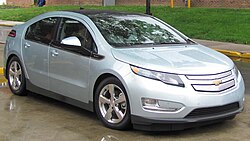Chevrolet Volt/Chevy Volt
According to General Motors the Volt can travel 25 to 50 miles (40 to 80 km) on its lithium-ion battery alone. The EPA official all-electric range is 35 miles (56 km), and the total range is 379 miles (610 km). The EPA rated 2011 model year Volt's combined city/highway fuel economy at 93 mpg-US (2.5 L/100 km; 112 mpg-imp) equivalent (MPG-e) in all-electric mode, and at 37 mpg-US (6.4 L/100 km; 44 mpg-imp) in gasoline-only mode, for an overall combined gasoline-electric fuel economy rating of 60 mpg-US (3.9 L/100 km; 72 mpg-imp) equivalent. The 2012 model year Volt received a revised EPA rating, increasing the combined city/highway fuel economy in all-electric mode to 94 MPG-e.The Volt operates as a pure battery electric vehicle until its plug-in battery capacity drops to a predetermined threshold from full charge, at which point its gasoline engine powers an electric generator to extend the vehicle's range. The Volt's regenerative braking also contributes to the on-board electricity generation. In order to improve performance, the internal combustion engine may at times be engaged mechanically to assist both electric motors to propel the Volt.
The base suggested retail price for the 2011 Chevrolet Volt in the U.S. was US$40,280 before the US$7,500 U.S. federal tax credit and additional incentives are available in some locations. The 2012 Volt base price is US$1,005 less than the 2011 model, as features have been removed from the base configuration. The Volt was sold initially only in selected U.S. markets and became available nationwide in November 2011. Deliveries of the 2012 Volt began in Canada in September 2011, and the suggested retail price starts at CAD 41,545 (US$43,568) before any available rebates. The initial Canadian launch is also limited to selected markets and availability in the rest of Canada is expected before the end of 2012. In China the Volt's price starts at RMB 498,000 (around US$75,500) and initial sales will be limited to eight cities.In the Eurozone the Volt will also be sold as the Opel/Vauxhall Ampera, at a price of €42,900 (US$58,000) including VAT before any government incentives. Deliveries of the first Chevrolet Volts in Europe began in France in November 2011. Customer deliveries of the Opel Ampera were delayed in Europe until the National Highway Traffic Safety Administration (NHTSA) completes its investigation of the Volt's battery fire risk after test crashes. In the United Kingdom the Volt platform will be sold as Vauxhall Ampera at a price of GB£33,995 (US$53,000) and deliveries are scheduled to begin in May 2012. In Australia the plug-in hybrid will be sold as the Holden Volt and its launch is scheduled by late 2012. Since its launch in December 2010 cumulative sales and customer deliveries in the U.S. and Canada reached 8,272 Volts through December 2011.
Among other awards and recognition, the Chevrolet Volt won the 2009 Green Car Vision Award, 2011 Motor Trend Car of the Year, 2011 Green Car of the Year, 2011 North American Car of the Year, and 2011 World Green Car. Despite the awards earned and the positive reception from many automotive critics, there has been some controversy and concerns in the media. These include the extent of the federal government participation in the Volt development during General Motors' 2009 government-led bankruptcy; concerns about the Volt's relatively high sales price; complaints about price markups due to the Volt's initial limited supply; and concerns about the battery pack fire risk after a crash.
Terminology
Further information: Hybrid vehicle drivetrain
The Society of Automotive Engineers' (SAE) definition of a hybrid vehicle states that the vehicle shall have "two or more energy storage systems both of which must provide propulsion power, either together or independently." General Motors has avoided the use of the term "hybrid" when describing its Voltec designs, even after the carmaker revealed that in some cases the combustion engine provided some assist at high speeds or to improve performance. Instead General Motors describes the Volt as an electric vehicle equipped with a "range extending" gasoline powered internal combustion engine (ICE) as a genset and therefore dubbed the Volt an "Extended Range Electric Vehicle" or E-REV.In a January 2011 interview, the Chevy Volt's Global Chief Engineer, Pamela Fletcher, referred to the Volt as "an electric car with extended range."According to SAE's definition the Volt is a hybrid vehicle, due to the combination of an internal combustion engine and electric motors, and its configuration can be referred to as a plug-in hybrid.The Volt operates as a purely electric vehicle for the first 25 to 50 miles (40 to 80 km), after which it functions primarily as a series hybrid, as the internal combustion engine acts primarily as a generator to power the electric traction motor. When the initial pure EV battery capacity drops below a pre-established threshold from full charge and while the Volt is operating in series hybrid mode, the Volt's control system will select the most optimally efficient drive mode to improve performance and boost high-speed efficiency.
At certain loads and speeds, 30 to 70 mph (48 to 110 km/h), the internal combustion engine may at times be engaged mechanically via a clutch to an output split planetary gearset in order to assist the electric traction motor propelling the Volt. Therefore, the Volt can operate either as an all-electric vehicle, a series hybrid or a parallel hybrid depending on the battery's state of charge (SOC) and the vehicle's operating conditions. The Volt has an automotive powertrain different from any existing car, but as a series hybrid or when in gasoline mode, the Volt operates similar to a conventional diesel-electric railroad locomotive which uses its combustion engine only to produce electricity to drive its electric traction motors, except under certain conditions when the Volt needs to improve its performance.
From Wikipedia, the free encyclopedia


Tidak ada komentar:
Posting Komentar